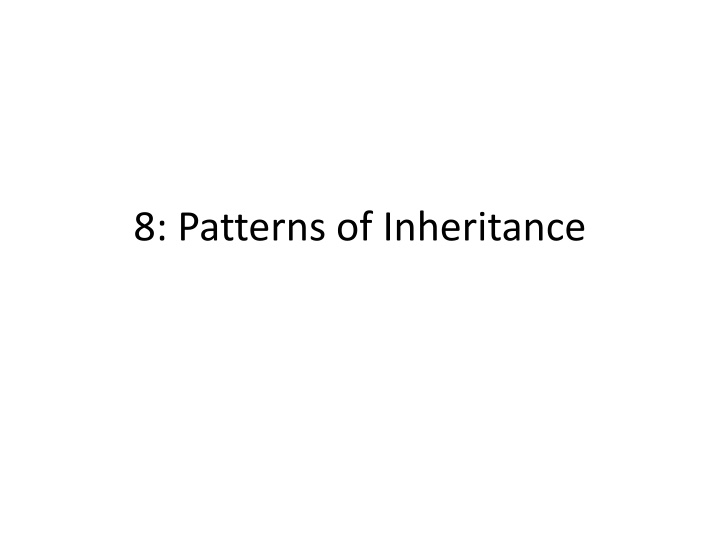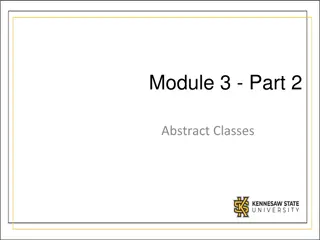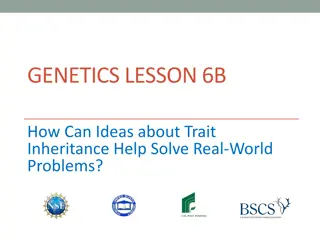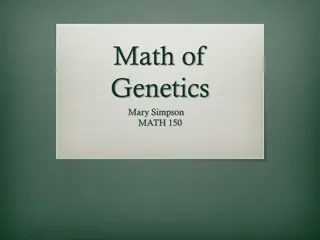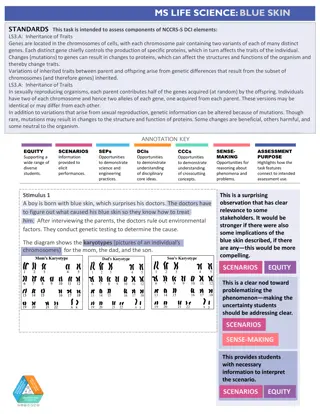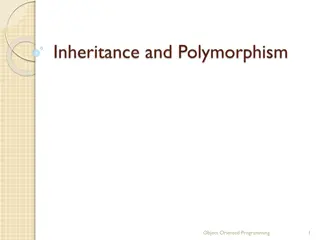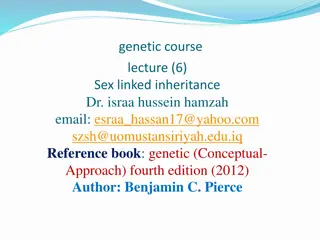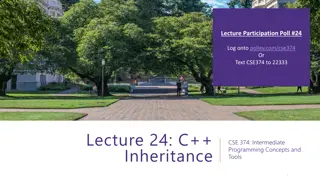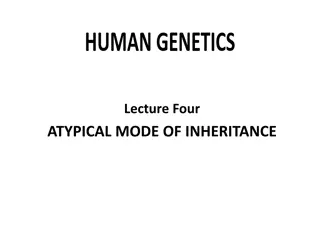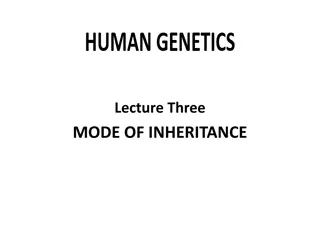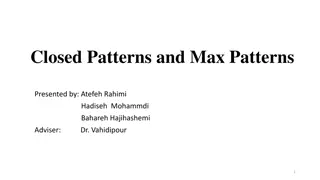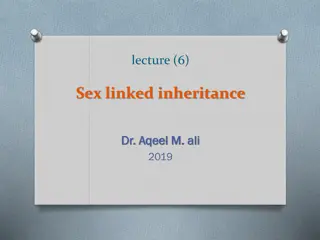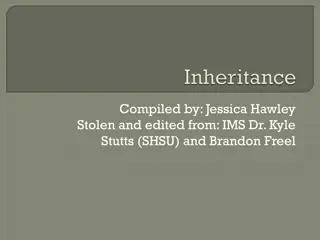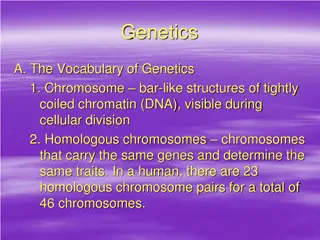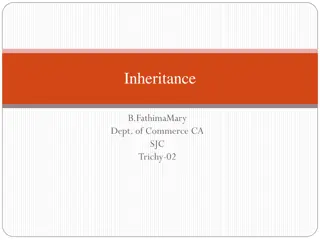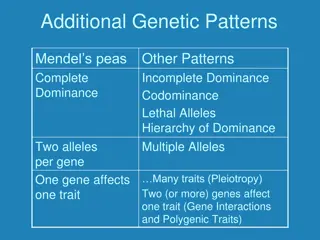8: Patterns of Inheritance
Gregor Mendel, an Austrian monk, formulated two fundamental laws of heredity in the 1860s based on garden pea experiments. His work introduced concepts like dominant and recessive traits, alleles, and the law of segregation through hybridizations and careful studies of pea plant characteristics.
Download Presentation

Please find below an Image/Link to download the presentation.
The content on the website is provided AS IS for your information and personal use only. It may not be sold, licensed, or shared on other websites without obtaining consent from the author.If you encounter any issues during the download, it is possible that the publisher has removed the file from their server.
You are allowed to download the files provided on this website for personal or commercial use, subject to the condition that they are used lawfully. All files are the property of their respective owners.
The content on the website is provided AS IS for your information and personal use only. It may not be sold, licensed, or shared on other websites without obtaining consent from the author.
E N D
Presentation Transcript
Gregor Mendel Austrian monk. Formulated two fundamental laws of heredity in the early 1860s. University of Vienna. At the time of his research, he was a substitute science teacher at a local technical high school. Because Mendel had a mathematical background, he used a statistical basis for his breeding experiments. Mendel s particulate theory is based on the existence of minute particles now called genes.
8.1 Medels Experiments Mendel prepared his experiments carefully and conducted preliminary studies. He chose the garden pea, Pisum sativum, because peas were easy to cultivate, had a short generation time, and could be cross-pollinated by hand. From many varieties, Mendel chose 22 true-breeding varieties for his experiments. True-breeding varieties had all offspring like the parents and like each other. Mendel studied simple traits (e.g., seed shape and color, flower color, etc.). He used his understanding of mathematical principles of probability to interpret his results.
Mendels Crosses Mendel performed hybridizations. He manually transferred pollen from the another of a mature pea plant of one variety to the stigma of a second variety. Plants used in first-generation crosses were called P plants. Mendel collected their seeds and grew them the following season. These offspring were called F1. After studying the first-generation, Mendel allowed them to self-fertilize naturally. He used those seeds to produce F2.. Mendel published his work in 1865. He studied 7 characteristics: plant height, seed texture, seed color, flower color, pea-pod size, pea-pod color, and flower position. Upon compiling his results for many thousands of plants, Mendel concluded that the characteristics could be divided into dominant and recessive traits. The physical observation of a dominant trait could mean that the genetic composition of the organism included two dominant versions or one dominant and one recessive version. The observation of a recessive trait meant that the organism lacked any dominant versions of the trait.
Some vocabulary locus is the specific location of alleles on homologous chromosomes. Alternative versions of a gene are called alleles. dominant allele masks or hides expression of a recessive allele; it is represented by an uppercase letter. recessive allele is an allele that exerts its effect only in the homozygous state; its expression is masked by a dominant allele; it is represented by a lowercase letter. The process of meiosis explains Mendel s law of segregation.
In Mendels cross, the parents were true- breeding; each parent had two identical alleles for a trait they were homozygous, indicating they possess two identical alleles for a trait. Homozygous dominant genotypes possess two dominant alleles for a trait. Homozygous recessive genotypes possess two recessive alleles for a trait. After cross-pollination, all individuals of the F1 generation had one of each type of allele. Heterozygous genotypes possess one of each allele for a particular trait. The allele not expressed in a heterozygote is a recessive allele.
8.2 Laws of Inheritance Mendel deduced from his results that each individual had two discrete copies of the characteristic that are passed individually to offspring. A diploid organism has two genetic copies that may or may not encode the same version of that characteristic. Gene variants that arise by mutation and exist at the same relative locations on homologous chromosomes are called alleles. Phenotype observable traits expressed by an organism Genotype organism s underlying genetic makeup, consisting of the physically visible and the non-expressed alleles.
Law of Dominance The law of dominance states that in a heterozygote, one trait will conceal the presence of another trait for the same characteristic. The dominant allele will be expressed exclusively. The recessive trait will only be expressed by offspring that have two copies of this allele, and these offspring will breed true when self-crossed. When fertilization occurs between two true-breeding parents that differ by only the characteristic being studied, the process is called a monohybrid cross. The offspring are called monohybrids.
Monohybrid Cross and the Punnett Square Mendel s research can be explained in terms of probabilities. A Punnett square is used to determine the probability of genotypes and phenotypes among offspring. Probability is the likely outcome a given event will occur from random chance. For example, with every coin flip there is a 50% chance of heads and 50% chance of tails. The product rule of probability states that the chance of two or more independent events occurring together is the product of the probability of the events occurring separately. The chance of inheriting a specific allele from one parent and a specific allele from another is x or . Possible combinations for the alleles Ee of heterozygous parents are the following: EE = x = eE = x = Ee = x = ee = x =
Testcrosses A testcross is used to determine if an individual with the dominant phenotype is homozygous dominant or heterozygous for a particular trait.
The sum rule of probability calculates the probability of an event that occurs in two or more independent ways; it is the sum of individual probabilities of each way an event can occur; in the above example where the phenotype unattached earlobes is dominant (EE, Ee, and eE), the chance for unattached earlobes is + + = .
Law of Segregation A monohybrid cross is between two parent organisms true-breeding for two distinct forms of one trait. Mendel tracked each trait through two generations. P generation is the parental generation in a breeding experiment. F1generation is the first-generation offspring in a breeding experiment. F2generation is the second-generation offspring in a breeding experiment.
He performed reciprocal crosses, i.e., pollen of tall plant to stigma of short plant and vice versa. His results were contrary to those predicted by a blending theory of inheritance. He found that the F1plants resembled only one of the parents. Characteristics of other parents reappeared in about 1/4 of F2plants; 3/4 of offspring resembled the F1plants.
Mendel saw that these 3:1 results were possible if: F1hybrids contained two factors for each trait, one being dominant and the other recessive; factors separated when gametes were formed; a gamete carried one copy of each factor; and random fusion of all possible gametes occurred upon fertilization.
Results of his experiments led Mendel to develop his first law of inheritance the law of segregation: Each organism contains two factors for each trait. Factors segregate during the formation of gametes. Each gamete contains one factor for each trait. Fertilization gives each new individual two factors for each trait.
The Law of Independent Assortment A dihybrid cross is between two parent organisms that are true-breeding for different forms of two traits; it produces offspring heterozygous for both traits. Mendel observed that the F1individuals were dominant in both traits. He further noted four phenotypes among F2 offspring; he deduced his second law of heredity-the law of independent assortment:
The law of independent assortment: Members of one pair of factors assort independently of members of another pair. All possible combinations of factors occur in gametes.
Dihybrid Cross A dihybrid cross in pea plants involves the genes for seed color and texture. The P cross produces F1offspring that are all heterozygous for both characteristics. The resulting 9:3:3:1 F2phenotypic ratio is obtained using a Punnett square.
8.3 Extensions of the Laws of Inheritance Mendel s work with pea plants suggested 3 things: Two types of units or alleles exist for every gene Alleles maintain their integrity in each generation In the presence of the dominant allele, the recessive allele is hidden, with no contribution to the phenotype Since Mendel, genetic studies show that much more complexity exists.
Incomplete Dominance Incomplete dominance means that one of the alleles appears in the phenotype in the heterozygote, but not to the exclusion of the other, which can also be seen.
Incomplete Dominance Human Example Curly versus Straight Hair in Caucasians A curly-haired Caucasian and a straight-haired Caucasian will have wavy-haired offspring. Two wavy-haired parents will produce a 1:2:1 ratio of curly-wavy-straight hair children.
Codominance Codominance means both alleles for the same characteristic are simultaneously expressed in the heterozygote. Multiple alleles may exist at a population level. When many alleles exist for the same gene, the convention is to denote the most common phenotype or genotype in the natural population as the wild type. All other phenotypes or genotypes are considered variants. The variant may be recessive or dominant to the wild-type allele. This occurs when a gene has many allelic forms or alternative expressions. ABO Blood Types The ABO system of human blood types is a multiple allele system. Two dominant alleles (IAand IB) code for presence of A and B glycoproteins on red blood cells. This also includes a recessive allele (iO) coding for no A or B glycoproteins on red blood cells. As a result, there are four possible phenotypes (blood types): A, B, AB, and O
Sex-linked traits Sex-Linked Traits When a female parent is homozygous for a recessive X-linked trait, she will pass the trait on to 100% of her male offspring because the males will receive the Y chromosome from the male. Color-blindness, hemophilia, and muscular dystrophy are X-linked. Females who are heterozygous for these diseases are said to be carriers and may not exhibit any phenotypic effects. These females will pass the disease to half of their sons and will pass carrier status to half of their daughters.
Fruit fly genetics Crosses involving sex-linked traits often give rise to different phenotypes for the different sexes of offspring, as is the case for this cross involving red and white eye color in Drosophila. In the diagram, w is the white-eye mutant allele and W is the wild-type, red-eye allele.
Whats a fruit fly got to do with me? When a female parent is homozygous recessive for an X-linked trait, she will pass that trait to all of her male offspring. Carrier status is passed to daughters. Color-blindness Hemophilia Muscular dystrophy
Epistasis In this example of epistasis, one gene (C)masks the expression of another (A) for coat color. When the C allele is present, coat color is expressed; when it is absent (cc), no coat color is expressed. Coat color depends on the A gene, which shows dominance, with the recessive homozygote showing a different phenotype than the heterozygote or dominant homozygote.
